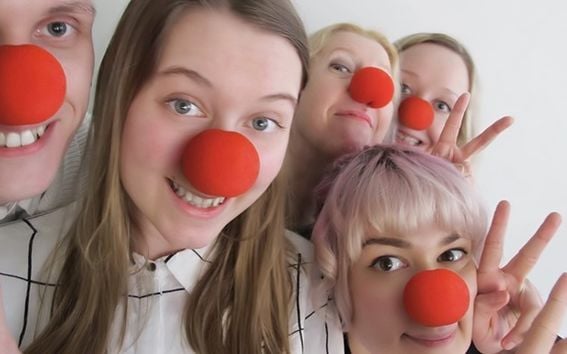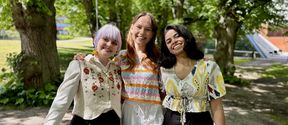No clowning about!

The students majoring in Costume Design at the Department of Film, Television and Scenography have started a collaborative project with the Finnish Hospital Clowns Association with the purpose of creating new costumes for the clowns working in hospitals. The Costume Design students in charge of designing and creating the costumes are Tiina Hauta-aho, Joona Huotari, Mimosa Kuusimäki and Vilma Väisänen under the direction of Merja Väisänen, lecturer in Costume Design, and Aino Viertola, General Manager of the Finnish Hospital Clowns Association.
The hospital clowns offer psychosocial support for children with chronic and acute illnesses. Armed with a great deal of humour, pranks and magic tricks, the hospital clowns are masters of improvisation whose visits help the children to forget about the hospital’s usual routine, their pain, their home sickness and their fear for a little while.
Hospital clowns can be found all over the world. The program was officially launched in Finland in 2002 at Helsinki University Central Hospital’s children’s hospital. The clowns can now be found all over the country in all university hospitals, i.e., Turku, Tampere, Kuopio and Oulu. The hospital clowns work in all wards, including the policlinics and the emergency room. The most important wards are the ones for children who suffer from the most serious illnesses and those in need of long-term care.
All hospital clowns are professional performers who have been trained as clown doctors by the Finnish Hospital Clowns Association. The association currently has approximately 45 trained clown doctors. In 2015 visits from the clown doctors cheered up approximately 46,000 young patients, family members and members of the medical staff.
The costume of a hospital clown plays an important role in the clowns’ work and their external visibility. The clown costume is the workwear of the performers; it helps them become the clown character, but it also needs to allow easy movement and transport of the equipment used during the performance. There are also special hygienic requirements placed on the costume of a hospital clown, and it must be easy to clean at the end of each working day.
For the children the clown costume acts as a visual impulse – even just seeing the colourful costume with all its fun details may cheer up a child tired out by treatment, or it can act as a gateway to a fairy tale world. Until now the clown doctors working as hospital clowns have been in charge of designing and acquiring their own costumes.
The aim of this new project is to enhance the professional status of hospital clowns with a costume that fulfils the requirements of both performance wear and workwear. The design process will create a shared identity for all hospital clowns, while also supporting each clown’s individual personality. The focus of the process is on playful, functional workwear that fulfils the hospitals’ hygiene requirements. This project supports the Finnish Hospital Clowns Association’s focus on improvement of their activities in order to meet the standards of the EFHCO (European Federation of Hospital Clown Organizations).
The activities of the Finnish Hospital Clowns Association are financed completely through grants and donations. The main sponsor is Finland’s Slot Machine Association (RAY), and grants have also been received from the Finnish Cultural Foundation and the Swedish Cultural Foundation in Finland, among others.
For this project, the costume design team at Aalto ARTS has received a grant from the Finnish Cultural Foundation. The project will also receive support from Marimekko, who is donating fabric for the costumes, and as the project moves forward, the team also intends to find more sponsors so that each hospital clown can get the costume they deserve.
The plan is to launch the clown doctors’ new costumes on the Finnish Hospital Clowns Association’s 15th anniversary on 17th February 2017. Later there will also be an official launch of the costumes when the team organises the great CLOWN FASHION SHOW, hopefully in connection with the opening of the new children’s hospital.
Further information:
School of Arts, Design and Architecture
Merja Väisänen, Lecturer on Costume Design
[email protected]
- Published:
- Updated:
Read more news

DeployAI Partners Gather for Heart Beat Meeting in Helsinki
The European DeployAI project's partners gathered for the Heart Beat meeting hosted by Aalto University Executive Education in Helsinki.
Online AI course could boost study equality
Students at the School of Business believe that mastering Artificial Intelligence (AI) can be beneficial for both academic success and career prospects, as AI becomes increasingly integrated into daily life.
2 027 new students admitted to Aalto University’s Finnish, Swedish bachelor’s programmes
13 500 applied to Aalto University in Finland's spring joint application in 2024